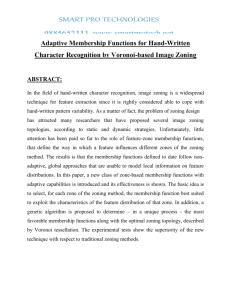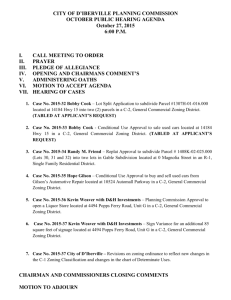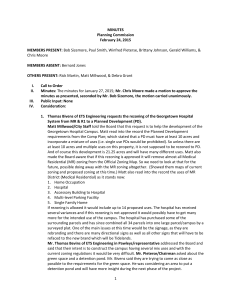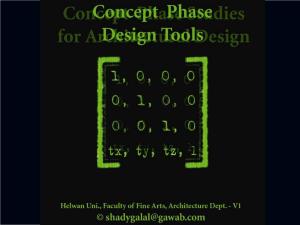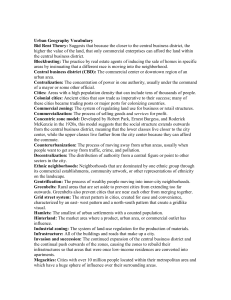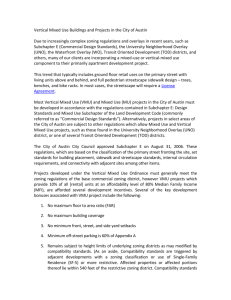Adaptive Membership Functions for Hand-Written
advertisement
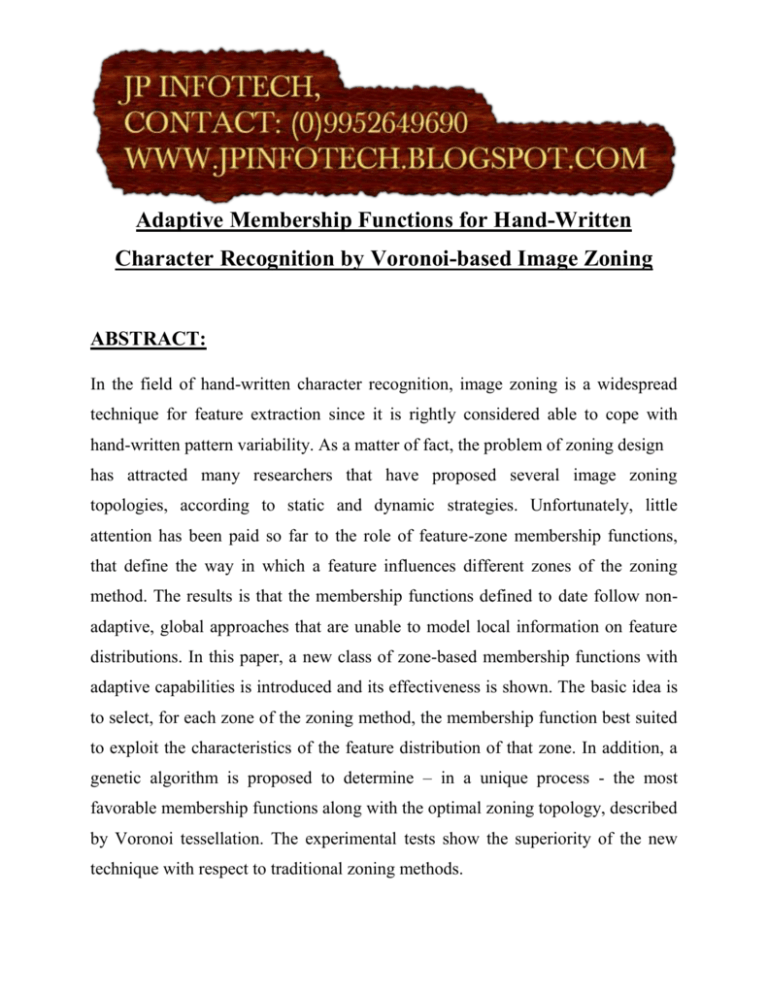
Adaptive Membership Functions for Hand-Written Character Recognition by Voronoi-based Image Zoning ABSTRACT: In the field of hand-written character recognition, image zoning is a widespread technique for feature extraction since it is rightly considered able to cope with hand-written pattern variability. As a matter of fact, the problem of zoning design has attracted many researchers that have proposed several image zoning topologies, according to static and dynamic strategies. Unfortunately, little attention has been paid so far to the role of feature-zone membership functions, that define the way in which a feature influences different zones of the zoning method. The results is that the membership functions defined to date follow nonadaptive, global approaches that are unable to model local information on feature distributions. In this paper, a new class of zone-based membership functions with adaptive capabilities is introduced and its effectiveness is shown. The basic idea is to select, for each zone of the zoning method, the membership function best suited to exploit the characteristics of the feature distribution of that zone. In addition, a genetic algorithm is proposed to determine – in a unique process - the most favorable membership functions along with the optimal zoning topology, described by Voronoi tessellation. The experimental tests show the superiority of the new technique with respect to traditional zoning methods. EXISTING SYSTEM: In existing system, the problem of zoning design has been mainly considered as related to the design of the topology to be used, that defines the way in which a pattern image must be segmented in order to extract as much discriminative information as possible. The approaches proposed so far for topology design can be divided into two categories: static and dynamic Traditional approaches involve static topologies that are designed without using apriori information on feature distributions in pattern classes. In this case, zoning design is performed according to experimental evidences or on the basis of intuition and experience of the designer. In general, static topologies are designed considering u×v regular grids that are superimposed on the pattern image, determining uniform partitions of the pattern image into regions of equal shape. DISADVANTAGES OF EXISTING SYSTEM: The problem of zoning design has been mainly considered as related to the design of the topology to be used, that defines the way in which a pattern image must be segmented in order to extract as much discriminative information as possible. The results is that the membership functions defined to date follow non-adaptive, global approaches that are unable to model local information on feature distributions. PROPOSED SYSTEM: The proposed system introduces a new class of zone-based membership functions with adaptive capabilities and presents a real-coded genetic algorithm for determining – in a single process - both the optimal zoning method, based on Voronoi tessellation of the pattern image, and the adaptive membership function most profitable for a given classification problem. Contrary to other approaches proposed in literature so far, the new class of membership functions allows the membership function to adapt to the specific feature distribution of each zone of the zoning method. ADVANTAGES OF PROPOSED SYSTEM: The experimental tests show the superiority of the new technique with respect to traditional zoning methods. The proposed system is capable of intelligible handwritten input from sources such as paper documents, photographs, touch-screens and other devices. Can be used effectively in many applications like: o Signature Verification o Postal-Address Interpretation o Bank-Check Processing MODULES: 1. Creating the Character Recognition System 2. Training 3. Abstract-level membership functions 4. Testing Phase MODULES DESCRIPTION: Creating the Character Recognition System The Character Recognition System must first be created through a few simple steps in order to prepare it for presentation into java. The matrixes of each letter of the alphabet must be created along with the network structure. In addition, one must understand how to pull the Binary Input Code from the matrix, and how to interpret the Binary Output Code, which the computer ultimately produces. First, in order to endow a computer with the ability to recognize characters, we must first create those characters. The first thing to think about when creating a matrix is the size that will be used. Too small and all the letters may not be able to be created, especially if you want to use two different fonts. On the other hand, if the size of the matrix is very big, there may be a few problems: Despite the fact that the speed of computers doubles every third year, there may not be enough processing power currently available to run in real time. Training may take days, and results may take hours. In addition, the computer’s memory may not be able to handle enough neurons in the hidden layer needed to efficient and accurately process the information. A large matrix size of 20 x 20 was created, through the steps as explained above, because it may not be able to process in real time. (See Figure 1) Training To create a network that can handle noisy input vectors it is best to train the network on both ideal and noisy vectors. To do this, the network is first trained on ideal vectors until it has a low sum squared error. Then, the network is trained on all sets of ideal and noisy vectors. The network is trained on two copies of the noise-free alphabet at the same time as it is trained on noisy vectors. The two copies of the noise-free alphabet are used to maintain the network's ability to classify ideal input vectors. Unfortunately, after the training described above the network may have learned to classify some difficult noisy vectors at the expense of properly classifying a noise-free vector. Therefore, the network is again trained on just ideal vectors. This ensures that the network responds perfectly when presented with an ideal letter. Training Phase Training Phase has various functionalities such as: Analyze image for characters Convert symbols to pixel matrices Retrieve corresponding desired output character and convert to Unicode Lineraize matrix and feed to network Compute output Compare output with desired output Unicode value and compute error Adjust weights accordingly and repeat process until preset number of iterations Abstract-level membership functions Membership functions at abstract-level assign Boolean influence weights on the basis of the first k zones in RISi (Ranked Index Sequence): This is the standard membership function used in traditional zoning-based classification. A character matrix is an array of black and white pixels; the vector of 1 represented by black, and 0 by white. They are created manually by the user, in whatever size or font imaginable; in addition, multiple fonts of the same alphabet may even be used under separate training sessions. Testing Phase Testing Phase has various functionalities such as: Analyze image for characters Convert symbols to pixel matrices Compute output Display character representation of the Unicode output The process of image analysis to detect character symbols by examining pixels is the core part of input set preparation in both the training and testing phase. Symbolic extents are recognized out of an input image file based on the color value of individual pixels, which for the limits of this project is assumed to be either black RGB(255,0,0,0) or white RGB(255,255,255,255). The input images are assumed to be in bitmap form of any resolution which can be mapped to an internal bitmap object in the Microsoft Visual Studio environment. The procedure also assumes the input image is composed of only characters and any other type of bounding object like a border line is not taken into consideration. SYSTEM REQUIREMENTS: HARDWARE REQUIREMENTS: PROCESSOR : PENTIUM IV 2.6 GHz RAM : 512 MB MONITOR : 15” HARD DISK : 20 GB CDDRIVE : 52X KEYBOARD : STANDARD 102 KEYS MOUSE : 3 BUTTONS SOFTWARE REQUIREMENTS: FRONT END : JAVA (APPLET) TOOLS USED : JFRAME BUILDER OPERATING SYSTEM: WINDOWS XP REFERENCE: G. Pirlo, Member, IEEE, D. Impedovo, Member, IEEE, “Adaptive Membership Functions for Hand-Written Character Recognition by Voronoi-based Image Zoning”, IEEE TRANSACTIONS ON IMAGE PROCESSING, 2012.

